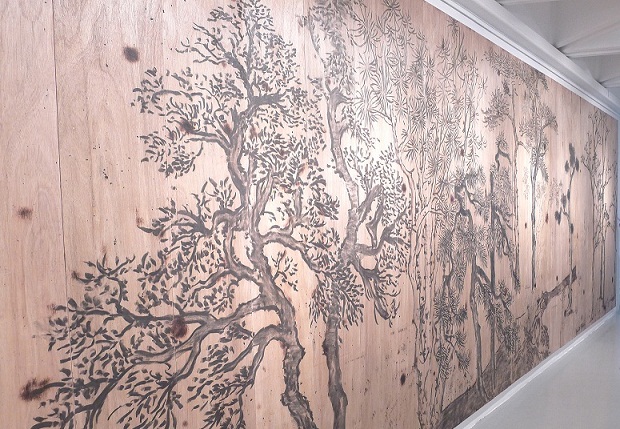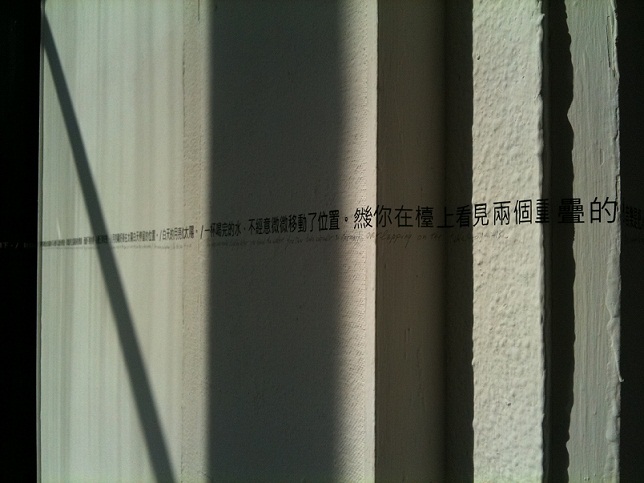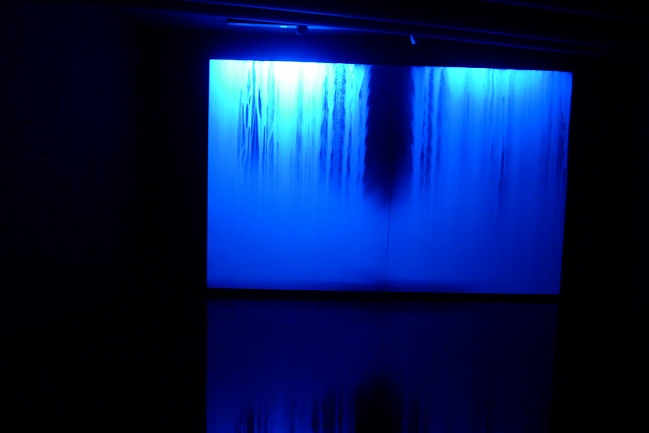Reviews & Articles
Vision of Nature: Lost & Found in Asian Contemporary Art
Yuen Lai Winnie Chan 陳婉麗
at 10:23am on 20th January 2012



Captions
- & 2. Takashi Kuribayashi, Wald aus Wald (Forest from Forest), Paper, wood and paint, 2011, dimensions variable. (Photo: Courtesy of John Batten)
- Lam Tung Pang, Past Continuous Tense. (Photo: Courtesy of John Batten).
- Pak Sheung-chuen, 2011-7-27 – 2011-11-14. (Photo: Courtesy of Yuen Lai Winnie Chan)
- Hiroshi Senju, Waterfall (Day Falls/Night Falls series). (Photo: Courtesy of Yuen Lai Winnie Chan)
This review has kindly been provided by Yuen Lai Winnie Chan, currently studying for a DPhil in Chinese Studies, University of Oxford.
The role played by Asian art in the international contemporary art scene has grown in recent years, exemplified by the many art exhibitions, biennales and artist awards now seen. The shift from a Western-centered, modernist discourse to a more postmodern, multicultural and multi-centred (Asia, Middle East, etc) ground has been growing like “the roots of a potato,” as described by Fumio Nanjo of Mori Museum Japan, the co-curator of the exhibition – “Vision of Nature: Lost and Found in Asia Contemporary Art” invites the audience to uncover the forgotten pieces in the city and to reconnect with nature through this work by eight emerging Asian artists from Hong Kong, Taiwan, Japan and China.
In Search of an East Asian Landscape
The subject of lost and found is reminded to us in the Biblical landscape of the Garden of Eden from John Milton’s epic poem Paradise Lost (1667): nature as God’s creation and the search for nature by humans expelled from Eden. This divide between man and nature had been fundamental to the history of landscape in Western art. The concept of nature in Asia is different and Fumio Nanjo has referred to nature as holistic, emerging by itself, and growing; and that manmade environments are considered part of nature. Recognizing the dissimilarity in concept of the man/nature relationship is crucial in the understanding of landscape art from the two traditions. To find ways of approaching Asian landscape, it is important to bear in mind the different governing aesthetic system in East Asia, wherein a shared philosophy (Confucius, Buddhist and Taoist) and rich literary tradition (the writing/written character) are closely linked within the domain of “East Asian” culture.
Tradition as Sources of Inspirations
Interestingly, three of the participating artists bring forth the theme of the forest. Takashi Kuribayashi creates a white forest wonderland using traditional papier-mâché in his work Wald aus Wald (Forest from Forest). He asks a perplexing question: what is landscape? If the paper is used for making a book, no-one would think it is nature; but what about making a paper landscape? By intentionally hiding and revealing its parts, the landscape unveils itself as the audience peers through holes when they move at various levels on the landscaped terrain that spans across the gallery space – an experience that is not quite dissimilar to viewing a traditional Chinese/Japanese scroll painting.
In Past Continuous Tense, the Hong Kong based artist Lam Tung Pang takes on a less-explored subject matter in Chinese ink painting: the forest fire. He paints the fire scene and the collapsing trees with charcoal on plywood combined with rubbing, erasing and burning to represent human’s destruction towards nature. Lam selects source images of nature (trees) from Chinese painting manuals that allow the viewer to glimpse a book showing a thousand year Chinese painting tradition dating from the Song dynasty.
The Chinese painter Zeng Fanzhi paints with his usual vividly coloured oils and shaped brushstrokes in Monkey and Hyaenas (part of the Chaotic Strokes series) tells of the cruel reality of life, death, with animals hunting and fighting for prey and hiding behind bushes in the wildness from danger.
Art that Links with Life
Another theme in focus during this exhibition is the representation of the everyday experience through visuality, installation, film and text. Danny Lee Chin Fai’s Urban Waterscape provides an urban green site by placing ripple-like, curvy benches outside the Hong Kong Arts Centre that imitates the movement of water and reflects the changing sky. The cinematographer Apichatpong Weerasethakul, in his documentary film Uncle Boonmee Who Can Recall His Past Lives, invites the audience to partake in the journey of Uncle Boonmee in the countryside of Thailand where natural and supernatural, past and present all come together.
The conceptual work of Pak Sheung-chuen is a criticism towards our lost senses of responding to our surroundings. In order to recover this sense, Pak embarks on a journal project 2011-7-27 – 2011-11-14, by jotting down sentences of inspiration that flash through his mind as he wanders in the city in a relaxed state of mind. Out of the 400 ideas he noted down over a period of three months (which have also been published as a book), some thirty sentences are selected in the exhibition work. One sentence reads: “Give yourself fewer choices, spend less money, slow down your life. Such backwardness is an progressive alternative.” (Journal of Pak Sheung-cheun 2011-7-27 – 2011-11-14 (Hong Kong Arts Centre, 2011), p. 56) His work reminds us of the classic work Xianqing ouji (Random Jottings of My Leisurely Mood) (1671) by novelist Li Yu, the aesthetic thoughts as well as idleness as an attitude of life for the cultivated Chinese gentleman of that time.
Reaching Out For New Forms
A new direction in art is the new art forms that cross genres and disciplines and the exploration on new media and technology. Works by Hiroshi Senju and the Taiwan team LuxuryLogico are concerned with two natural elements: water and light. Hiroshi Senju applies florescence mineral pigments on mulberry paper that grow under ultraviolet illumination. Waterfall (Day Falls/Night Falls series) captures the mystic and spiritual power of nature. The cycle of day and night, the falling water and the reflection of the marble flooring signify life, eternity, rebirth and dreams. On the other hand, LuxuryLogico generates a gigantic light source from unwanted lamps that raises environmental protection issues. Entitled Solar, the variegated artificial lights with different temperatures serves as a metaphor that, although people live in different (light) conditions, we all observe the universe through light and our imagination.
A more critical take for artists on both the bright and dark sides of human’s relationship with nature is still being sought. Yet, new sensitivity, concept and vision of art on nature have been nicely approached in this refreshing exhibition.
Exhibition: Vision of Nature: Lost & Found in Asian Contemporary Art
Date: 10.12.2011 – 29.1.2012
Venue: Pao Galleries, Hong Kong Arts Centre
http://www.hkac.org.hk/en/calendar.php?id=661
Behind the scene footage of the exhibition: http://www.youtube.com/watch?v=vlX4fKnihVs
|
|
|
|
|
|
